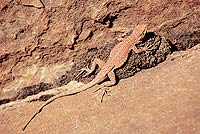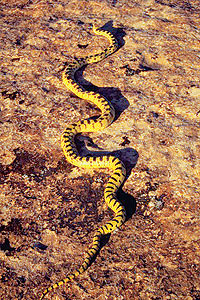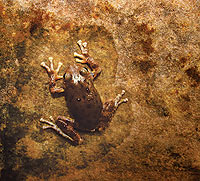 The Canyonlands Region is home to a diverse group of reptiles and amphibians. Lizards and snakes seem right at home in the desert heat but there are also several different amphibians: toads, frogs, and salamanders that inhabit wet habitats.
The Canyonlands Region is home to a diverse group of reptiles and amphibians. Lizards and snakes seem right at home in the desert heat but there are also several different amphibians: toads, frogs, and salamanders that inhabit wet habitats.
Lizards. The side-blotched lizard, named after the dark armpit patches behind their forelegs, and the tree lizard, named after its arboreal tendencies, are the smallest lizards one may encounter. Both are agile climbers, clinging to rock faces or scurrying along tree branches. Their prey includes insects and arthropods such as spiders and scorpions. The side-blotched lizards scientific name, Uta stansburiana, refers to the state of Utah and honors Captain Howard Stansbury who collected the first specimens for science back in the 1840s.

Named after its spotted body and pronounced snout, the long-nosed leopard lizard is a long-tailed lizard that preys upon insects, small rodents, and smaller lizards. During the breeding season when the females are gravid (pregnant or carrying eggs), they develop orangish spots on their sides.
Another large lizard in the region is the collared lizard, a spectacular contrast of colors with a yellow head, black neck bands, and turquoise body with yellowish spots. A unique attribute of the collared lizard is its ability to stand up and run on just its hind feet while chasing after grasshoppers, other lizards, or fleeing from a predator. This bipedal motion inspires a vision of a miniature T-rex.
Snakes. The warning “buzz” of a rattlesnake is one of those international sounds. The rapidly vibrating buttons at the tip of the tail warn any potential predator or nearby animal to the snake’s presence. Coiled and ready to strike if provoked, these snakes produce venom in their fangs that acts as a neurotoxin, affecting the nervous system and muscles of any prey. The midget-faded rattlesnake, named for its small size, is a subspecies of the western rattlesnake. The snake’s toxin is very potent, so heed their buzz and give these reclusive creatures their space.
Mimicking their distant relatives, gopher or bull snakes, will also coil up, flatten their heads, and vibrate their tail to warn predators away. However, these snakes are not pit vipers and are non-venomous. They grab prey with their mouths, then coil their bodies around the prey. These constrictors consume their prey whole and will eat rodents, small mammals, lizards, eggs, and nestling birds. They are agile climbers, as well.
 Amphibians. Toads, frogs, and salamanders inhabit canyon streams, potholes, stock ponds, or other water sources in Canyon Country. Toads, known for their warty, dry skin gather to breed in pools or ponds. The males chorus at night to attract females; the red-spotted toad produces a repetitive trill that pierces the desert night.
Amphibians. Toads, frogs, and salamanders inhabit canyon streams, potholes, stock ponds, or other water sources in Canyon Country. Toads, known for their warty, dry skin gather to breed in pools or ponds. The males chorus at night to attract females; the red-spotted toad produces a repetitive trill that pierces the desert night.
In contrast, frogs have smoother, wetter skin and are likely to be found near water. The canyon treefrog, known for its suction-cup like toe pads, produces a more guttural call, sometimes sounding like a bleating sheep, to attract mates.
Tiger salamanders are another amphibian found in Canyon Country but rarely seen because of their nocturnal habits. Considered a “mole salamander,” these creatures spend a great deal of time in burrows where they feed on worms, invertebrates, mice, and even small snakes. Born in water, the larval stage eats aquatic invertebrates and tadpoles. The young have gills which they may retain in their adult phase, as well.
Keep an eye out for these interesting and unique species of wildlife during your stay in the desert. Please respect their space and resist the urge to grab a lizard – you might injury its tail which may prove fatal.